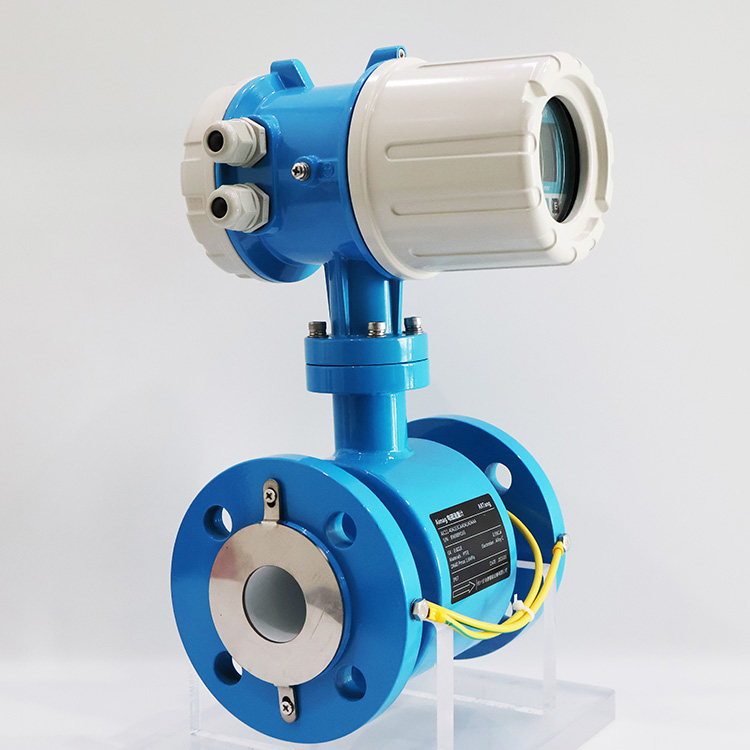Views: 184 Author: Site Editor Publish Time: 2021-08-22 Origin: Site








Electromagnetic flowmeters use Faraday's law to determine the flow of liquid in the pipeline. As a result, the flow of the conductive liquid through the magnetic field causes the electrodes located on the wall of the flow tube to sense a voltage signal. The voltage generated is proportional to the movement of the flowing liquid. In other words, the faster the fluid flows, the greater the voltage generated. Therefore, the electromagnetic flowmeter processes the voltage signal to determine the liquid flow rate.
1. No Moving Parts
Electromagnetic flow meters have no mechanical components in contact with the fluid, reducing wear and tear.
This results in lower maintenance requirements and longer operational life.
2. High Accuracy and Reliability
EMFs provide highly accurate flow measurements, typically within ±0.5% of the reading.
They are not affected by changes in fluid density, viscosity, or temperature, ensuring consistent performance.
3. Wide Range of Applications
Suitable for measuring the flow of conductive liquids, including water, acids, alkalis, slurries, and corrosive fluids.
Commonly used in industries such as water and wastewater, chemical, food and beverage, pharmaceuticals, and mining.
4. Bidirectional Flow Measurement
Electromagnetic flow meters can measure flow in both directions, making them versatile for applications requiring reverse flow monitoring.
5. Low Pressure Drop
The design of EMFs creates minimal obstruction to the flow, resulting in a very low pressure drop across the meter.
This is particularly beneficial for energy efficiency in pumping systems.
6. Handles a Wide Range of Fluid Conductivities
EMFs can measure fluids with low conductivity (as low as 5 µS/cm in some models), making them suitable for a variety of liquids.
7. Excellent for Abrasive and Corrosive Fluids
The absence of moving parts and the availability of corrosion-resistant linings (e.g., PTFE, PFA, ceramic) make EMFs ideal for abrasive or corrosive fluids.
8. No Obstruction to Flow
The full-bore design of EMFs allows the fluid to pass through without any obstructions, preventing clogging and making them suitable for slurries and dirty liquids.
9. Wide Range of Sizes
Electromagnetic flow meters are available in a wide range of sizes, from small diameters (a few millimeters) to large diameters (several meters), accommodating various flow rates and pipe sizes.

electromagnetic flow measurement

magnetic flow transmitter
10. Easy to Install and Maintain
EMFs are relatively easy to install, with options for flanged, wafer, or insertion-type installations.
Their simple design and lack of moving parts reduce maintenance requirements and downtime.
11. Compatibility with Hygienic Applications
EMFs with smooth linings (e.g., PFA or PTFE) are suitable for hygienic applications, such as in the food, beverage, and pharmaceutical industries.
12. Digital and Smart Features
Modern electromagnetic flow meters often come with advanced features, such as digital signal processing, self-diagnostics, and communication protocols (e.g., HART, Modbus, Profibus).
These features enhance accuracy, reliability, and integration with control systems.
13. Long-Term Stability
EMFs maintain their calibration and accuracy over long periods, reducing the need for frequent recalibration.
14. Environmentally Friendly
Since EMFs do not introduce any contaminants into the fluid and have no mechanical parts that can degrade, they are environmentally friendly and suitable for sensitive applications.
All of our full-bore electromagnetic flowmeters provide a complete solution for continuous measurement or batch control, suitable for a variety of applications from water treatment to sanitary food and beverage or pharmaceutical applications.
The main limitations of electromagnetic flow meters are as follows:
They cannot be used to measure gases, steam, or liquids containing a large amount of gas.
They have certain restrictions, as they can only measure the flow of conductive liquids, not non-conductive media.
Installation and commissioning are more complex and require stricter conditions compared to other flow meters. The installation site must be free from vibration and strong magnetic fields. The transmitter and pipeline must have good contact and proper grounding. Any residual gas inside the measuring tube must be completely removed during operation; otherwise, significant measurement errors may occur.
When measuring viscous liquids containing dirt, if viscous substances or sediments adhere to the inner wall of the measuring tube or the electrodes, once the buildup on the electrodes reaches a certain thickness, the instrument may fail to measure properly.
About ARTang
ARTang is a global leader in measurement instrumentation, services and solutions for industrial process engineering that energizes the transformation of society and industry to achieve a more productive, sustainable future. We provide process solutions for flow, level, pressure, analytics and digital communications, optimizing processes in terms of economic efficiency, safety & environmental impact.
